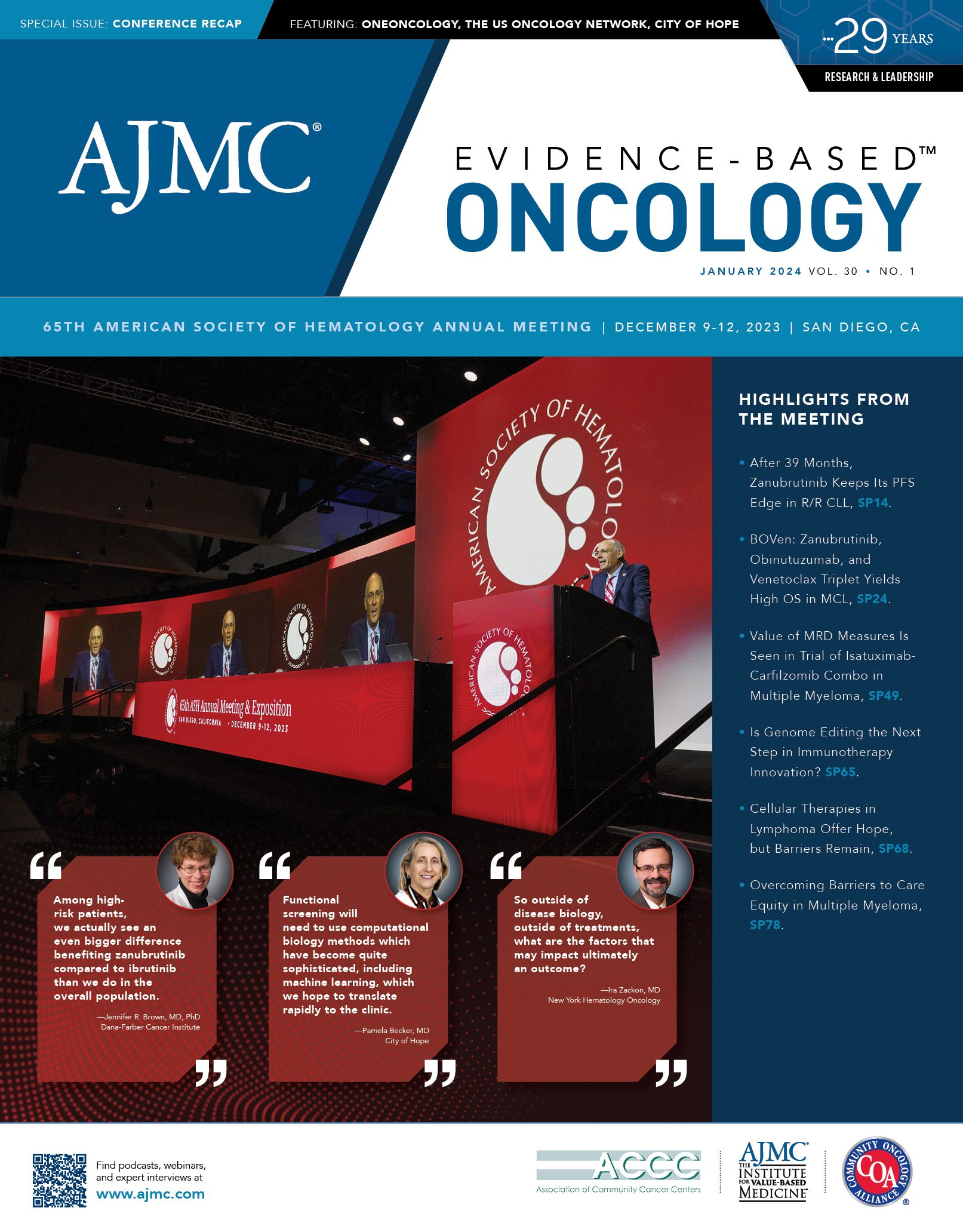- Center on Health Equity & Access
- Clinical
- Health Care Cost
- Health Care Delivery
- Insurance
- Policy
- Technology
- Value-Based Care
ASH 2023: Coverage of MCL
Selected coverage of mantle cell lymphoma (MCL) from the 65th American Society of Hematology Annual Meeting and Exposition, December 9-12, 2023, San Diego, California.
BOVen: Zanubrutinib, Obinutuzumab, and Venetoclax Triplet Yields 75% OS at 2 Years in High-Risk MCL
Patients with TP53-mutant mantle cell lymphoma (MCL) have historically faced a lack of standard frontline treatment and poor survival prospects; a 2017 study found that chemoimmunotherapy regimens offered patients a median overall survival (OS) of 1.8 years.1
Since then, a 2018 study by Tam et al in the New England Journal of Medicine that combined ibrutinib, a Bruton tyrosine kinase (BTK) inhibitor, with venetoclax, a therapy to target BCL2 protein, showed promise in relapsed or refractory MCL, even for patients with this high-risk mutation.2 Following a 2021 study that showed positive results when patients with untreated MCL received ibrutinib (Imbruvica), the CD20-targeting antibody obinutuzumab (Gazyva), and venetoclax (Venclexta),3 investigators from Memorial Sloan Kettering Cancer Center (MSK) and Massachusetts General Hospital (MGH) developed the BOVen study (NCT03824483), which replaced the ibrutinib with the second-generation BTK inhibitor zanubrutinib (Brukinsa).4 The triplet is also being studied in chronic lymphocytic leukemia and small lymphocytic lymphoma.
Anita Kumar, MD | Image: MSK

In a packed session December 11, 2023, at the 65th American Society of Hematology Annual Meeting and Exposition in San Diego, California, lead investigator Anita Kumar, MD, an MSK lymphoma specialist in Basking Ridge, New Jersey, presented phase 2 results for 25 patients with TP53 mutations. The primary end point was 2-year progression-free survival (PFS), which was achieved after a median follow-up
of 23.3 months.5
“Based on historical data, we found a 2-year PFS rate of greater than or equal to 55% to be promising and an unacceptable rate to be less than or equal to 30%,” Kumar said. “Therefore, if 11 or more patients were progression free at 2 years, the treatment regimen will be declared effective.”
Kumar emphasized that BTK-BCL2 inhibition in MCL is well grounded; she noted that the ASH late-breaking session included from the phase 3 SYMPATICO trial (NCT03112174) examining use of ibrutinib and venetoclax in relapsed/refractory MCL (See SP26). Nonetheless, the promise of fewer cardiac effects could make a zanubrutinib-based regimen more attractive to patients and clinicians alike in light of other evidence that the second-generation therapy is more effective than ibrutinib in patients with TP53 mutations.
Methods. The regimen was administered as follows: 160 mg zanubrutinib (oral) was given daily starting on day 1, 1000 mg obinutuzumab was given (intravenously) starting on day 1 or split on day 1-2, day 8 and day 15 of cycle 1; and on day 1 of cycles 2-8, with venetoclax ramp up starting on day 1 of cycle 3.
Results. Kumar said based on results from the first 25 patients, BOVen is expanding from MSK and MGH to 2 more sites at Northwestern and Emory universities. Results thus far show the following:
- The median age of the study group was 68 years (range, 29 to 82); 76% were male.
- 100% of the patients had stage IV disease; 68% were high-risk, 28% were intermediate and 4% were low-risk based on MCL International Prognostic Index scores.
- 100% of patients had a TP53 mutation, 44% of the patients also had 17p deletion, and 33% had a K-i67 marker of 50%.
There were 5 progressions, 3 of which occurred in the first year of treatment. - The study reported 4 deaths; 2 deaths were COVID-19 related, 1 was from postoperative pneumonia, and 1 was from an unknown cause. All patients who died were in ongoing response at the time of death.
- After 2 cycles of obinutuzumab and venetoclax, as assessed by PET-CT, overall response rate (ORR) was 76%, with a complete metabolic response rate of 68%.
- Best ORR was 96% (24/25) with 88% achieving a complete response (22/25).
- The 2-year PFS was 72%, and the median was not reached. The 2-year OS was 75%, and the median was not reached. “Therefore, we have achieved the primary PFS end point of this study with 11 patients who are progression free at 2 years,” Kumar said.
Adverse events (AEs). Overall, the regimen was safe and well tolerated, Kumar said. The most common AEs were diarrhea, COVID-19 infection, neutropenia, and infusion-related infections. Kumar said grade 3 neutropenia was present in 16% of patients and resolved with granulocyte colony–stimulating factor, and diarrhea was primarily grade 1 and manageable.
“We were interested in characterizing the incidence of clinically significant tumor lysis syndrome (TLS), particularly during the venetoclax ramp-up,” she said. However, after 2 cycles of obinutuzumab and zanubrutinib, only 3 patients were at risk of TLS and required initial inpatient venetoclax ramp-up.
“BOVen emerges as a promising treatment option for TP53-mutant mantle cell lymphoma,” Kumar said. “We’ve expanded the study to include an additional 25 patients.”
References
1. Eskelund CW, Dahl C, Hansen JW, et al. TP53 mutations identify younger mantle cell lymphoma patients who do not benefit from intensive chemoimmunotherapy. Blood. 2017;130(17):1903-1910. doi:10.1182/blood-2017-04-779736
2. Tam CS, Anderson MA, Pott C, Ibrutinib plus venetoclax for the treatment of mantle-cell lymphoma. N Engl J Med. 2018;378(13):1211-1223. doi:10.1056/NEJMoa1715519
3. Le Gouill S, Morschhauser F, Chiron D, et al. Ibrutinib, obinutuzumab, and venetoclax in relapsed and untreated patients with mantle cell lymphoma: a phase 1/2 trial. Blood. 2021;137(7):877-887. doi:10.1182/blood.2020008727
4. Phase 2 study of zanubrutinib, obinutuzumab, and venetoclax in previously untreated patients with chronic lymphocytic leukemia (CLL) or small lymphocytic lymphoma (SLL) and mantle cell Lymphoma (MCL). ClinicalTrials.gov. Updated September 18, 2023. Accessed December 12, 2023. https://clinicaltrials.gov/study/NCT03824483
5. Kumar A, Soumerai J, Abramson JS, et al. A multicenter phase 2 trial of zanubrutinib, obinutuzumab, and venetoclax (BOVen) in patients with treatment-naïve, TP53-mutant mantle cell lymphoma. Presented at: 65th American Society of Hematology Annual Meeting and Exposition; December 9-12, 2023; San Diego, CA. Abstract 0738. doi:10.1182/blood-2023-180069
Ibrutinib Plus Venetoclax Confers PFS, Response Benefit in Relapsed/Refractory MCL
Treatment with the oral Bruton tyrosine kinase (BTK) inhibitor ibrutinib (Imbruvica) in combination with venetoclax (Venclexta) led to a significant improvement in progression-free survival (PFS) and complete response (CR) rate compared with ibrutinib plus placebo in patients with relapsed/refractory mantle cell lymphoma (MCL), according to findings from the primary analysis of the phase 3 SYMPATICO study (NCT03112174).1
Michael Wang, MD | Image: MD Anderson

Findings were presented by Michael Wang, MD, a professor in the Department of Lymphoma/Myeloma, Division of Cancer Medicine, The University of Texas MD Anderson Cancer Center in Houston, during the late-breaking session of the 65th American Society of Hematology Annual Meeting and Exposition, held in San Diego, California.
However, his remarks hinted at the lack of a path forward for this combination in the United States, given AbbVie’s decision to voluntarily withdraw ibrutinib’s accelerated approvals in MCL and marginal zone lyphoma.2
Data from the study demonstrated that the median investigator-assessed PFS with global censoring was 31.9 months among the 134 patients in the ibrutinib plus venetoclax arm, compared with 22.1 months in the 133 patients in the ibrutinib plus placebo arm (HR, 0.65; 95% CI, 0.47-0.88; log-rank P = .0052). Additionally, the median PFS per independent review committee (IRC) with global censoring (HR, 0.67; 95% CI, 0.49-0.91; log-rank P = .0108), by investigator assessment with US FDA censoring (HR, 0.60; 95% CI, 0.44-0.83; log-rank P = .0021), and by IRC assessment with US FDA censoring (HR, 0.63; 95% CI, 0.45-0.87; log-rank P = .0057), all favored the combination arm over placebo.
Moreover, the overall response rate (ORR) in the combination arm was 82% with a 54% CR rate vs 74% with a 32% CR rate in the placebo arm. The median duration of response (DOR) was 42.1 months vs 27.6 months, respectively.
“Ibrutinib is an oral BTK inhibitor that is approved in many countries for relapsed/refractory MCL,” Wang said during the presentation. “Venetoclax is an oral BCL2 inhibitor that’s also approved in multiple countries to treat chronic lymphocytic leukemia and untreated acute myeloid leukemia. The combination of these 2 agents leverages complementary modes of action and has demonstrated synergistic antitumor activity in preclinical models of MCL. Furthermore, in patients with relapsed/refractory MCL, promising clinical activity has also been observed with the combination of the 2 [agents] in early phase studies.”
SYMPATICO was a multinational, double-blind study that enrolled patients with relapsed/refractory MCL who received 1 to 5 prior therapies for MCL. Eligible patients were at least aged 18 years, had an ECOG performance status of 2 or less, and received at least 1 prior anti-CD20–containing regimen or rituximab (Rituxan). Stratification occurred based on ECOG performance status, prior lines of therapy, and tumor lysis syndrome risk.
Patients were randomly assigned 1:1 to receive ibrutinib 560 mg once daily for 24 months in combination with venetoclax or placebo. enetoclax was given via a 5-week ramp-up to 400 mg once daily for 24 months. After 24 months, all patients received single-agent ibrutinib 560 mg once daily until disease progression or unacceptable toxicity.
The primary end point was PFS by investigator assessment per Lugano criteria. Secondary end points included investigator-ssessed CR rate, time to next treatment, overall survival (OS), and ORR by investigator assessment.
Additional findings revealed that OS was numerically improved in the combination arm compared with the placebo arm at this interim analysis. The median OS was 44.9 months vs 38.6 months, respectively (HR, 0.85; 95% CI, 0.62-1.19; log-rank P = .3465).
In terms of safety, most patients in the combination (n = 134) and placebo (n = 132) arms experienced grade 3 or higher adverse effects (AEs; 84% vs 76%, respectively) and serious AEs (60% vs 60%). AEs leading to discontinuation (31% vs 36%), dose reduction (36% vs 22%), and death (16% vs 14%) were reported in both arms, respectively. Tumor lysis syndrome by laboratory assessment occurred in 7 and 3 patients, respectively.
The most frequent any-grade AEs in the combination arm included diarrhea (65%), neutropenia (34%), nausea (31%), fatigue (29%), anemia (22%), pyrexia (21%), cough (20%), and muscle spasms (8%); these events occurred at rates of 34%, 14%, 17%, 27%, 12%, 20%, 27%, and 24%, in the placebo arm, respectively. The most common grade 3 or higher AEs in the investigational vs placebo arm consisted of neutropenia (31% vs 11%), pneumonia (13% vs 11%), thrombocytopenia (13% vs 8%), anemia (10% vs 3%), diarrhea (8% vs 2%), leukopenia (7% vs 0%), worsening of MCL without disease progression (7% vs 12%), atrial fibrillation (5% vs 5%), COVID-19 (5% vs 1%), and hypertension (4% vs 9%).
The median treatment duration in the combination arm was 22.2 months (range, 0.5-60.4). In the placebo arm, the median treatment duration was 17.7 months (range, 0.1-58.9).
“In conclusion, ibrutinib [plus] venetoclax achieved a statistically significant improvement in PFS compared with ibrutinib plus placebo,” Wang said. “This combination [displayed] robust benefit across all sensitivity analyses. CR rate and time to next therapy was significantly statistically improved. OS was numerically but not statistically significantly improved at this interim analysis. The addition of venetoclax to ibrutinib has a favorable benefit to risk ratio in patients with relapsed/refractory MCL. In my personal opinion, this combination in the countries where ibrutinib is indicated should be a new standard therapy for relapsed/refractory MCL.”
This article first appeared on OncLive.
References
1. Wang M, Jurczak W, Trněný M, et al. Ibrutinib combined with venetoclax in patients with relapsed/refractory mantle cell lymphoma: primary analysis results from the randomized phase 3 SYMPATICO study. Presented at: 65th American Society of Hematology Annual Meeting and Exposition; December 9-12, 2023; San Diego, CA. Abstract LBA-2. doi:10.1182/blood-2023-191921
2. Update on withdrawal of ibrutinib accelerated approvals for MCL and MZL in the United States. The ASCO Post. Updated April 14, 2023. Accessed December 17, 2023. https://bit.ly/3RJo8YW
Pirtobrutinib Displays Activity in Relapsed/Refractory MCL Following Covalent BTK Inhibitor Therapy
The highly selective, noncovalent Bruton tyrosine kinase (BTK) inhibitor pirtobrutinib (Jaypirca) demonstrated promising efficacy and a tolerable safety profile in heavily pretreated patients with relapsed/refractory mantle cell lymphoma (MCL) who received prior therapy with a covalent BTK inhibitor, according to findings from the phase 1/2 BRUIN trial (NCT03740529) presented during the 65th American Society of Hematology Annual Meeting and Exposition, held December 9-12, 2023.1
In the study, 152 patients with MCL who received prior treatment with a covalent BTK inhibitor achieved an overall response rate (ORR) of 49.3% (95% CI, 41.1%-57.6%) including a 15.8% complete response (CR) rate. The median time to first response was 1.8 months (range, 0.8-13.8). At a median follow-up of 14.7 months, the median duration of response (DOR) was 21.6 months (95% CI, 9.2-27.2).
Additionally, at a median follow-up of 15.9 months, the median progression-free survival (PFS) was 5.6 months (95% CI, 5.3-9.2). At a median follow-up of 24.2 months, the median overall survival (OS) was 23.5 months (95% CI, 17.1-not evaluable [NE]).
Jonathon Cohen, MD, MS | Image: Emory University

“There’s been a number of series [of data] over the last several years which have continued to demonstrate that patients with relapsed/refractory MCL who experience disease progression or otherwise have to discontinue a covalent BTK inhibitor have a very poor prognosis with a median OS of less than 1 year,” Jonathon B. Cohen, MD, MS, the codirector of the Lymphoma Program and the chair of the Data and Safety Monitoring Committee at Winship Cancer Institute of Emory University, as well as an associate professor in the Department of Hematology and Medical Oncology at Emory University School of Medicine, all in Atlanta, Georgia, said during the presentation.
“Fortunately, pirtobrutinib has been shown to be efficacious in this setting. As a result of these findings, pirtobrutinib is now approved to treat relapsed/refractory MCL in adults both in the United States as well as in Europe.”
In addition, there were 14 patients naive to a covalent BTK inhibitor with an ORR of 85.7% (95% CI, 57.2%-98.2%), including a CR rate of 42.9%. The median DOR, PFS, and OS were NE (95% CI, 13.0-NE), NE (95% CI, 16.7-NE), and NE (95% CI, NE-NE), respectively.
“It’s very important to stress that this was a cohort of 14 patients, but certainly very encouraging data [in this group of patients],”
Cohen noted.
BRUIN Trial Patient Characteristics
BRUIN was a dose escalation and expansion study that enrolled 166 adult patients with MCL, 317 chronic lymphocytic leukemia/small lymphocytic lymphoma, and 295 with other histologic subtypes. Eligible patients were at least aged 18 years with an ECOG performance status of 2 or less, received previous treatment, and had active disease in need of treatment.
During the phase 1 dose escalation and expansion phase, patients received pirtobrutinib monotherapy at a dose ranging from 25 mg to 300 mg once daily. Phase 1 used a 3+3 design in 28-day cycles, intra-patient dose escalation was permitted, and cohort expansion was allowed at doses that were deemed to be safe. In the phase 2 portion, patients received pirtobrutinib 200 mg once daily.
The coprimary end points in phase 1 were determining the maximum tolerated as well as the recommended dose phase 2 dose. In phase 1b the coprimary end points were determining the safety of pirtobrutinib in combination with venetoclax (Venclexta) as well as with venetoclax and rituximab (Rituxan). The primary end point in phase 2 was ORR per independent review committee. Secondary end points included investigator-assessed ORR, OS, DOR, PFS, pharmacokinetics, and safety.2
The baseline patient characteristics among patients with MCL in the prior covalent BTK inhibitor and covalent BTK inhibitor-naive subgroups were generally well balanced; the median age was 70 years (range, 46-88) and 67 years (range, 60-86), respectively. Most patients in both arms were males (79% vs 71%), had classic/leukemic histology (79% vs 79%), and had bulky lymphadenopathy less than 5 cm (62% vs 57%).1
The median number of prior lines of systemic treatment received in the prior covalent BTK inhibitor and covalent BTK inhibitor-naive subgroups were 3 (range, 1-9) and 2 (range, 1-3), respectively. Prior lines of therapy included BTK inhibitor (100% vs 0%), anti-CD20 antibody (97% vs 100%), chemotherapy (90% vs 100%), immunomodulator (17% vs 7%), stem cell transplant (22% vs 50%), BCL2 inhibitor (16% vs 0%), CAR T-cell (9% vs 0%), and PI3K inhibitor (4% vs 7%). Patients who received prior BTK inhibitor treatment discontinued due to progressive disease (84%), toxicity/other reasons (14%), and unknown reasons (2%).
In terms of TP53 mutation status, patients in the prior covalent BTK inhibitor and covalent BTK inhibitor-naive subgroups had mutations (20% vs 21%), no mutations (20% vs 29%), and missing status (61% vs 50%). Patients had a Ki-67 index of less than 30% (12% vs 14%), 30% or more (30% vs 43%), and missing (59% vs 43%), respectively.
Additional Findings From Subgroup Analyses
Data from subgroup analyses revealed that patients who received prior covalent BTK inhibitor treatment with a Ki-67 index of less than 30% (n = 18) and 30% or more (n = 45) achieved a median PFS of 19.5 months (95% CI, 3.5-NE) vs 5.3 months (95% CI, 3.0-9.1), respectively. The median DOR was 17.7 months (95% CI, 1.9-NE) vs 21.6 months (95% CI, 5.6-27.2), respectively, and the median OS was NE (95% CI, 9.4-NE) vs 23.4 months (95% CI, 13.1-NE), respectively.
Among patients previously treated with a covalent BTK inhibitor who had unmutated TP53 (n = 30) and mutated TP53 (n = 30), the median PFS was 6.9 months (95% CI, 3.7-16.6) vs 3.7 months (95% CI, 1.8-5.5), respectively. The median DOR was 14.8 months (95% CI, 1.9-NE) vs 17.6 months (95% CI, 1.7-NE), respectively, and the median OS was NE (95% CI, 10.7-NE) vs 15.9 months (95% CI, 7.8-NE), respectively.
Patients with MCL who received prior covalent BTK inhibitor treatment experienced efficacy following pirtobrutinib therapy across subgroups. Notably, patients who discontinued prior BTK therapy due to toxicity or other reasons (n = 21), with a Ki-67 index of less than 30% and a low-risk sMIPI score (n = 30) achieved ORRs of 90.5% (95% CI, 69.6%-98.8%), 66.7% (95% CI, 41.0%-86.7%), and 66.7% (95% CI, 47.2%-82.7%), respectively.
A Manageable Safety Profile
Regarding safety, any-grade adverse effects (AEs) among patients with MCL (n = 166) included fatigue (31.9%), diarrhea (22.3%), dyspnea (17.5%), anemia (16.9%), and decreased platelet count (15.1%). These events occurred at grade 3 or higher severity at rates of 3.0%, 0.0%, 1.2%, 7.8%, and 7.8%, respectively. Treatment-related AEs (TRAEs) of any grade included fatigue (21.1%), diarrhea (12.7%), dyspnea (9.0%), anemia (7.2%), and decreased platelet count (7.8%). Grade 3 or higher TRAEs consisted of fatigue (2.4%), anemia (2.4%), decreased platelet count (3.0%), and dyspnea (0.6%).
Any-grade AEs of special interest included infections (42.8%), bruising (16.3%), rash (14.5%), arthralgia (9.0%), hemorrhage (10.2%), hypertension (4.2%), and atrial fibrillation/flutter (3.6%). These events were reported at grade 3 or higher severity at rates of 19.9%, 0.0%, 0.6%, 1.2%, 2.4%, 0.6%, and 1.8%, respectively. Treatment-related infections (15.7%), bruising (11.4%), rash (9%), arthralgia (2.4%), hemorrhage (4.2%), hypertension (1.8%), and atrial fibrillation/flutter (0.6%) were all present; 3.6% of patients experienced grade 3 or higher infections and 0.6% experienced grade 3 or higher hemorrhage.
The median time on treatment in the overall MCL cohort was 5.5 months. Discontinuations and dose reductions due to TRAEs occurred at rates of 3% and 5%, respectively.
“There were low rates of discontinuation due to clearly drug-related toxicity,” Cohen said. “For many of us, [pirtobrutinib] a new standard of care for patients who have received a prior covalent BTK inhibitor.
There’s now an ongoing, randomized, global phase 3 trial [BRUIN MCL-321 (NCT04662255)] which is comparing pirtobrutinib with investigator’s choice of covalent BTK inhibitor in patients with relapsed MCL who are otherwise BTK-[inhibitor] naive. This will be an important study to help us better understand where the different BTK inhibitors fit in treatment sequencing for patients with relapsed disease.”
This article first appeared on OncLive.
References
1. Cohen JB, Shah NN, Jurczak W, et al. Pirtobrutinib in relapsed/refractory (R/R) mantle cell lymphoma (MCL) patients with prior cBTKi: safety and efficacy including high-risk subgroup analyses from the phase 1/2 BRUIN study. Blood. 2023;142(suppl 1):981. doi:10.1182/blood-2023-181627
2. A study of oral LOXO-305 in patients with previously treated CLL/SLL or NHL. ClinicalTrials.gov. Updated March 8, 2023. Accessed December 12, 2023. https://clinicaltrials.gov/study/NCT03740529

Trends in Hospital Pricing for Vulnerable Emergency Department Users, 2021-2023
December 4th 2025Self-pay emergency department prices rose significantly from 2021 to 2023, especially at for-profit and system-affiliated hospitals, highlighting growing affordability challenges for uninsured and underinsured patients.
Read More
